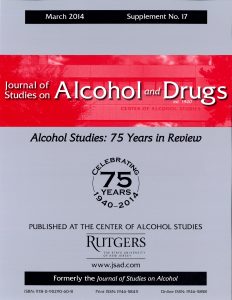In 1940, the United States was barely 7 years past the end of its experiment with the national prohibition of alcohol, and relatively little was known about the effects of alcohol on the human body and society overall. How could one define “intoxication”? Did alcohol problems result from the excessive consumption of any type of alcohol or just distilled spirits? How were other psychiatric problems and alcohol abuse interrelated? Was alcoholism just a problem for those on “Skid Row”?
 To help address alcohol problems from a scientific perspective, researchers from what would become the Rutgers Center of Alcohol Studies formed the Quarterly Journal of Studies on Alcohol, at the time the only journal of its kind published in the United States.
To help address alcohol problems from a scientific perspective, researchers from what would become the Rutgers Center of Alcohol Studies formed the Quarterly Journal of Studies on Alcohol, at the time the only journal of its kind published in the United States.
On this, the 75th anniversary of what is now the Journal of Studies on Alcohol and Drugs, the journal offers a series of reviews of the alcohol-science literature, from the 1940s to the present. In this special issue— (Journal of Studies on Alcohol and Drugs, Supplement No. 17)—top researchers in the alcohol-studies field review topics frequently covered in the journal, such as college student drinking, multicultural issues, comorbidity, genetics, psychosocial approaches, pharmacotherapy, prevention, control policy, and the legal minimum drinking age. Together, the authors provide a view of substance use research from the very inception of the field to the present day, documenting how far (and, at times, how little) the field has progressed toward prevention, treatment, and the minimization of harm caused by alcohol consumption.
—Paul Candon
–Originally published in the March 2014 issue of the CAS Information Services Newsletter. Written by Paul Candon, Managing Editor, JSAD